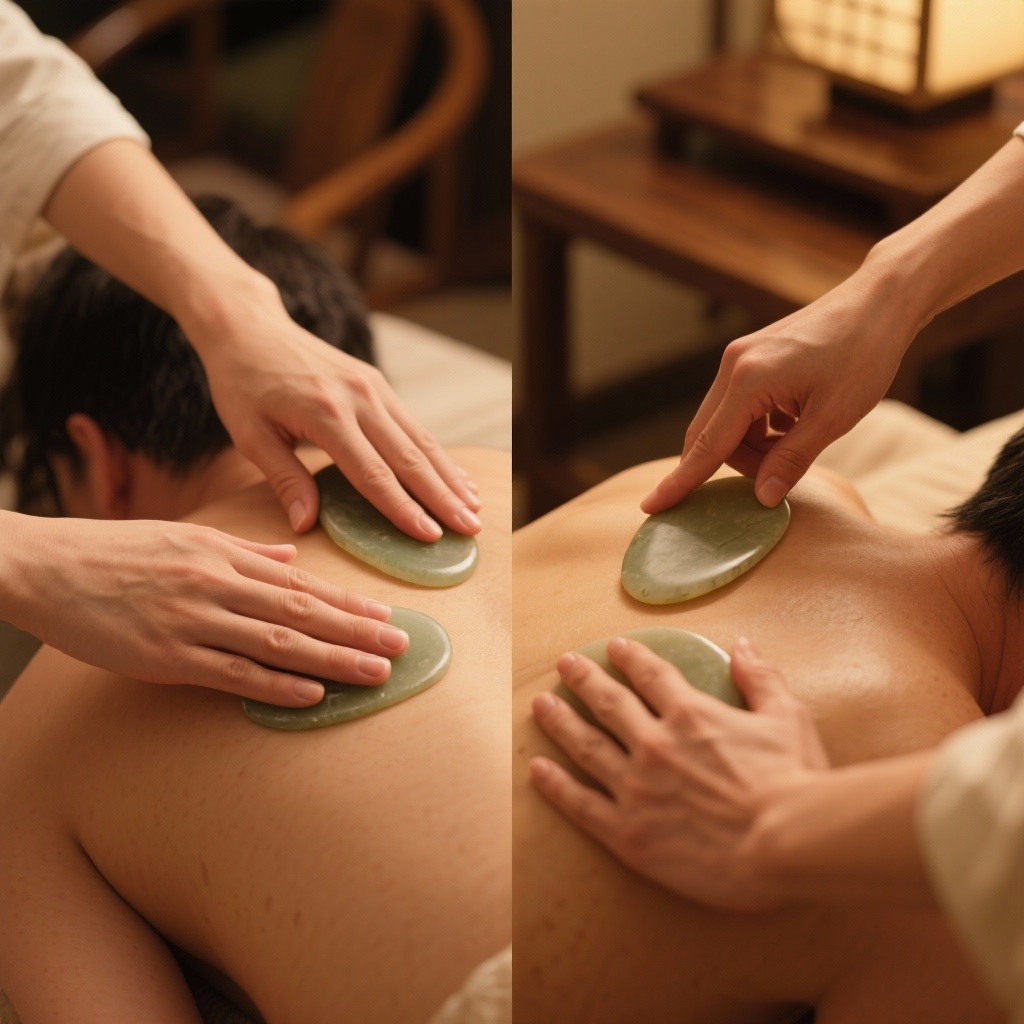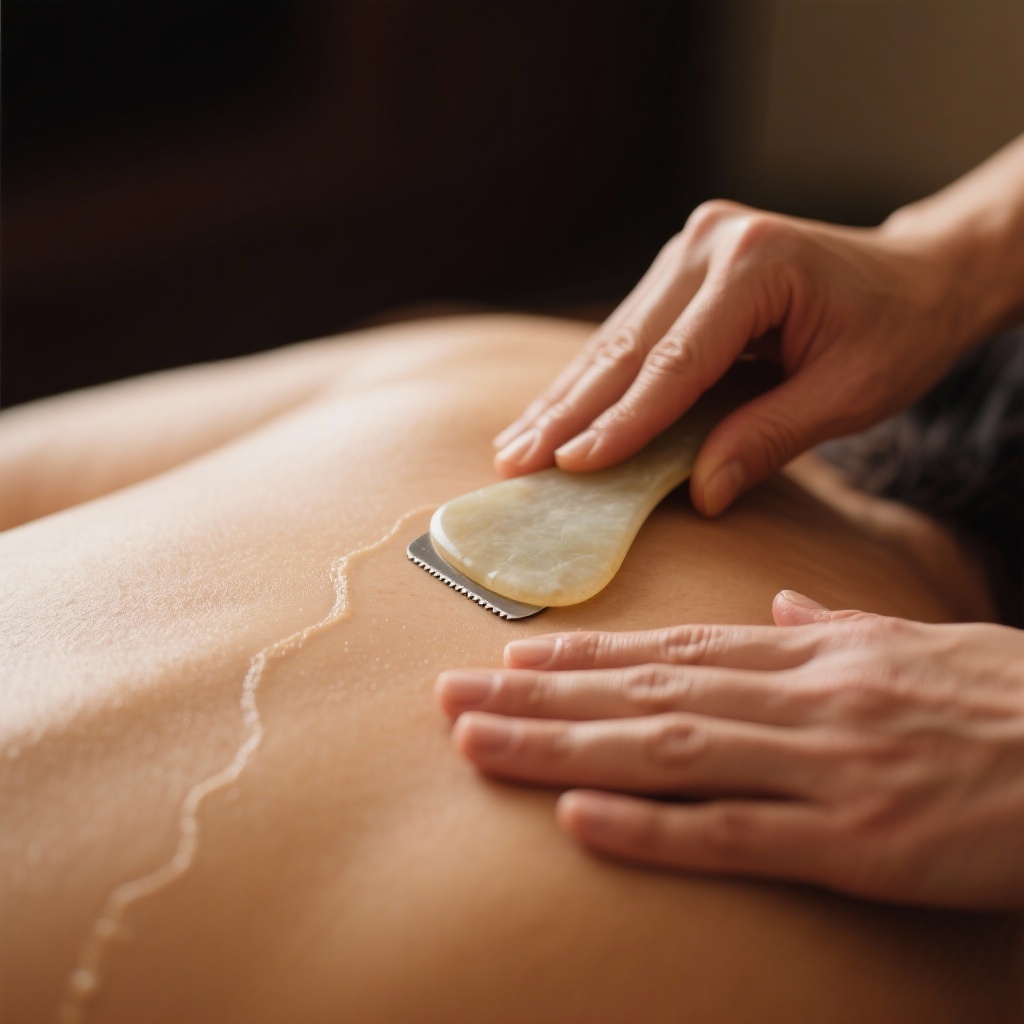Acutely Perceiving the Core Differences: Gua sha vs Tuina Massage
While both Gua sha and Tuina massage are traditional Chinese medicine (TCM) therapeutic techniques, they function like distinct tools for specific jobs. Understanding the distinctions between Gua sha and Tuina massage is crucial for choosing the right approach for your well-being. Both aim to restore balance, but their methods and optimal applications vary significantly. This guide unpacks their core differences.

Uncover the Method: How Gua sha Works
Gua sha, often called a “surface clearing method,” involves using a specialized tool to scrape the skin. This mechanical stimulation activates energy pathways directly beneath the surface. It helps to clear out what TCM calls “pathogenic factors.” These factors are like unwanted guests trying to leave your system, creating internal disruption (Wang et al., 2020).
Activate Energy: Gua sha for Surface Flow
This process encourages blood circulation and helps release muscular tension. It also promotes detoxification by bringing stagnant elements to the surface. Essentially, Gua sha focuses on superficial circulation.
Experience Deep Relief: How Tuina Transforms
Tuina massage, a “deep-level conditioning method,” applies various specific hand techniques on muscles and fascia. These presses, kneads, and pushes regulate vital Qi (energy) and Blood flow. This action effectively clears blockages within deeper energy channels (Luo et al., 2015).
Improve Internal Harmony: Tuina for Deep Balance
Tuina aims to harmonize internal organ function and restore systemic balance. It addresses the root causes of discomfort by working through layers of tissue. Explore more about Qi and Blood balance here: /tcm-basics/qi-blood/.
Profoundly Understanding Depth: Where Each Therapy Reaches
Penetrate the Surface: Gua sha’s Scope
Gua sha primarily targets the skin and superficial fascial layers of the body. It works like a quick “surface scrub” for your system. This technique rapidly disperses surface-level imbalances or “pathogenic factors.” Learn more about Gua sha here: /tcm-basics/gua-sha/.
Reach Deeper: Tuina’s Extensive Reach
Tuina massage, by contrast, reaches deep into muscles, joints, and even influences internal organs. This acts as a comprehensive “deep tissue work” experience. It adjusts organ function and balances deep Qi and Blood flow. Discover more about Tuina massage here: /tcm-basics/tuina-massage/.
Decisively Evaluating Effectiveness: Speed vs. Sustained Change
Find Quick Relief: Gua sha’s Rapid Impact
Gua sha excels at dispelling external pathogens and acute discomfort. It quickly alleviates colds, headaches, and acute muscle pain. However, its immediate effects are generally short-lived, offering temporary relief (Sun et al., 2021).
Build Lasting Wellness: Tuina’s Enduring Benefits
Tuina massage focuses on harmonizing Qi and Blood, providing lasting benefits. It addresses chronic pain, functional disorders, and overall constitutional improvements. It works to fundamentally enhance one’s body constitution.

Thoughtfully Considering Symptoms: Acute vs. Chronic Needs
Treat Acute Issues: Gua sha’s Best Fit
Gua sha is ideal for acute conditions demanding immediate attention. These include fever from a common cold, sudden headaches, muscle spasms, heatstroke, or acute digestive discomfort.
Address Chronic Concerns: Tuina’s Targeted Approach
Tuina massage addresses chronic, persistent issues more effectively. Examples include cervical spondylosis, lumbar disc herniation, insomnia, indigestion, sub-health management, and even pediatric wellness.
Carefully Observing Operation: Simplicity vs. Expertise
Embrace Simplicity: Gua sha for Home Use
Gua sha is a relatively straightforward and standardized technique to learn. Basic methods are sufficient for effective home self-care. Each Gua sha session typically lasts from 10 to 20 minutes.
Seek Expertise: Tuina’s Complex Art
Tuina massage involves diverse and complex hand techniques, requiring extensive training and profound skill. Treatments are highly individualized. Sessions generally last from 30 to 60 minutes.
Delightfully Experiencing Treatment: Sensation vs. Serenity
Notice the Marks: Gua sha’s Unique Sensation
During Gua sha, temporary “sha” marks, or reddish spots, may appear on the skin. You might experience a slight stinging sensation during treatment. This feeling usually subsides quickly.
Indulge in Comfort: Tuina’s Relaxing Effect
Tuina massage sessions are generally comfortable and deeply relaxing for most individuals. Patients often feel profound enjoyment. Some even drift off to sleep during the process.
Strategically Planning Frequency: Recovery vs. Routine Care
Allow Recovery: Gua sha’s Spaced Sessions
For Gua sha, sessions should be spaced 3 to 5 days apart. This allows the “sha” marks to fully fade before the next treatment.
Maintain Wellness: Tuina’s Regular Application
Tuina massage, especially for general wellness and maintenance, can be performed daily. This regularity supports ongoing health and relaxation.
Optimally Combining Applications: Synergistic Healing
Prioritize Relief: Choosing the Right First Step
For acute symptoms, Gua sha is often the preferred choice, offering rapid relief from discomfort. For chronic conditions and deeper regulation, Tuina massage provides sustained improvements.
Enhance Outcomes: The Power of Both
Combining both methods can yield superior results, offering comprehensive care. First, use Gua sha to clear superficial blockages. Then apply Tuina massage to regulate deeper systems. This addresses both symptoms and root causes effectively. Summarizing their essence, Gua sha addresses surface issues quickly, while Tuina targets deeper internal balance steadily. This distinction between Gua sha and Tuina massage is key for optimal healing practices, combining rapid symptom relief with long-term holistic well-being through ancient TCM bodywork techniques that support overall health and vitality, promoting balanced Qi flow and muscular relaxation.
References:
(Wang, Y. Y., et al. (2020). The effectiveness of Gua Sha on musculoskeletal pain: a systematic review and meta-analysis of randomized controlled trials. *Complementary Therapies in Medicine*, 49, 102319. [PMID: 32067746](https://pubmed.ncbi.nlm.nih.gov/32067746/))
(Luo, X., et al. (2015). Tuina for chronic low back pain: a systematic review and meta-analysis of randomized controlled trials. *PloS One*, 10(3), e0120108. [PMID: 25793444](https://pubmed.ncbi.nlm.nih.gov/25793444/))
(Sun, B., et al. (2021). The effects of Gua Sha on muscle soreness and performance recovery in athletes: A systematic review. *Journal of Sport and Health Science*, 10(6), 682-689. [PMID: 34182963](https://pubmed.ncbi.nlm.nih.gov/34182963/))
Quick Self-Test & Rescue: Find Your Healing Match Now!
Feeling stiff and a little under the weather with surface tension or an acute headache?
→ Immediately consider gentle Gua sha for quick surface relief. Try a simple self-scrape on your neck or shoulders.
Experiencing persistent low back pain, stress, or trouble sleeping?
→ Immediately try simple Tuina self-massage techniques to relax muscles and promote deeper relaxation. Focus on kneading tender spots.
Medical Disclaimer:This article is for educational use only and is not a substitute for professional medical advice.